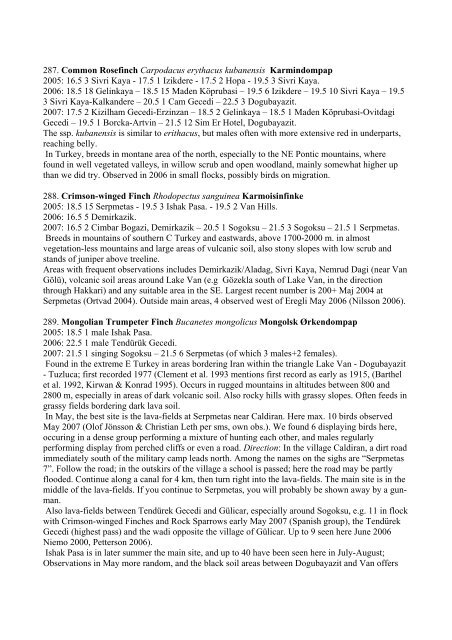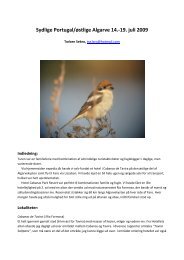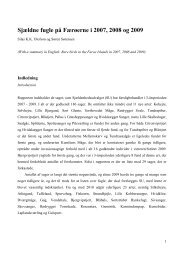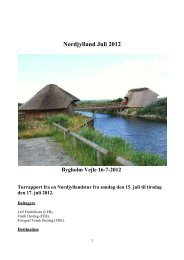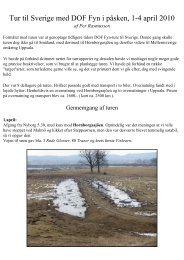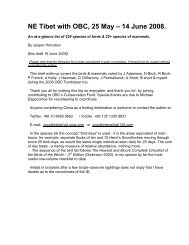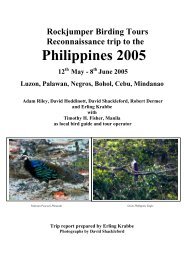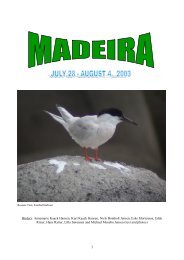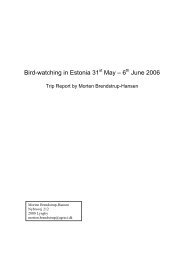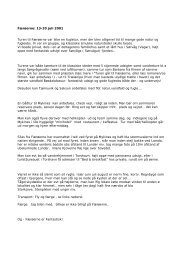TURKEY - a report from a birdwatching trip to Central ... - Netfugl.dk
TURKEY - a report from a birdwatching trip to Central ... - Netfugl.dk
TURKEY - a report from a birdwatching trip to Central ... - Netfugl.dk
Create successful ePaper yourself
Turn your PDF publications into a flip-book with our unique Google optimized e-Paper software.
287. Common Rosefinch Carpodacus erythacus kubanensis Karmindompap<br />
2005: 16.5 3 Sivri Kaya - 17.5 1 Izikdere - 17.5 2 Hopa - 19.5 3 Sivri Kaya.<br />
2006: 18.5 18 Gelinkaya – 18.5 15 Maden Köprubasi – 19.5 6 Izikdere – 19.5 10 Sivri Kaya – 19.5<br />
3 Sivri Kaya-Kalkandere – 20.5 1 Cam Gecedi – 22.5 3 Dogubayazit.<br />
2007: 17.5 2 Kizilham Gecedi-Erzinzan – 18.5 2 Gelinkaya – 18.5 1 Maden Köprubasi-Ovitdagi<br />
Gecedi – 19.5 1 Borcka-Artvin – 21.5 12 Sim Er Hotel, Dogubayazit.<br />
The ssp. kubanensis is similar <strong>to</strong> erithacus, but males often with more extensive red in underparts,<br />
reaching belly.<br />
In Turkey, breeds in montane area of the north, especially <strong>to</strong> the NE Pontic mountains, where<br />
found in well vegetated valleys, in willow scrub and open woodland, mainly somewhat higher up<br />
than we did try. Observed in 2006 in small flocks, possibly birds on migration.<br />
288. Crimson-winged Finch Rhodopectus sanguinea Karmoisinfinke<br />
2005: 18.5 15 Serpmetas - 19.5 3 Ishak Pasa. - 19.5 2 Van Hills.<br />
2006: 16.5 5 Demirkazik.<br />
2007: 16.5 2 Cimbar Bogazi, Demirkazik – 20.5 1 Sogoksu – 21.5 3 Sogoksu – 21.5 1 Serpmetas.<br />
Breeds in mountains of southern C Turkey and eastwards, above 1700-2000 m. in almost<br />
vegetation-less mountains and large areas of vulcanic soil, also s<strong>to</strong>ny slopes with low scrub and<br />
stands of juniper above treeline.<br />
Areas with frequent observations includes Demirkazik/Aladag, Sivri Kaya, Nemrud Dagi (near Van<br />
Gölü), volcanic soil areas around Lake Van (e.g Gözekla south of Lake Van, in the direction<br />
through Hakkari) and any suitable area in the SE. Largest recent number is 200+ Maj 2004 at<br />
Serpmetas (Ortvad 2004). Outside main areas, 4 observed west of Eregli May 2006 (Nilsson 2006).<br />
289. Mongolian Trumpeter Finch Bucanetes mongolicus Mongolsk Ørkendompap<br />
2005: 18.5 1 male Ishak Pasa.<br />
2006: 22.5 1 male Tendürük Gecedi.<br />
2007: 21.5 1 singing Sogoksu – 21.5 6 Serpmetas (of which 3 males+2 females).<br />
Found in the extreme E Turkey in areas bordering Iran within the triangle Lake Van - Dogubayazit<br />
- Tuzluca; first recorded 1977 (Clement et al. 1993 mentions first record as early as 1915, (Barthel<br />
et al. 1992, Kirwan & Konrad 1995). Occurs in rugged mountains in altitudes between 800 and<br />
2800 m, especially in areas of dark volcanic soil. Also rocky hills with grassy slopes. Often feeds in<br />
grassy fields bordering dark lava soil.<br />
In May, the best site is the lava-fields at Serpmetas near Caldiran. Here max. 10 birds observed<br />
May 2007 (Olof Jönsson & Christian Leth per sms, own obs.). We found 6 displaying birds here,<br />
occuring in a dense group performing a mixture of hunting each other, and males regularly<br />
performing display <strong>from</strong> perched cliffs or even a road. Direction: In the village Caldiran, a dirt road<br />
immediately south of the military camp leads north. Among the names on the sighs are “Serpmetas<br />
7”. Follow the road; in the outskirs of the village a school is passed; here the road may be partly<br />
flooded. Continue along a canal for 4 km, then turn right in<strong>to</strong> the lava-fields. The main site is in the<br />
middle of the lava-fields. If you continue <strong>to</strong> Serpmetas, you will probably be shown away by a gunman.<br />
Also lava-fields between Tendürek Gecedi and Gülicar, especially around Sogoksu, e.g. 11 in flock<br />
with Crimson-winged Finches and Rock Sparrows early May 2007 (Spanish group), the Tendürek<br />
Gecedi (highest pass) and the wadi opposite the village of Gülicar. Up <strong>to</strong> 9 seen here June 2006<br />
Niemo 2000, Petterson 2006).<br />
Ishak Pasa is in later summer the main site, and up <strong>to</strong> 40 have been seen here in July-August;<br />
Observations in May more random, and the black soil areas between Dogubayazit and Van offers


